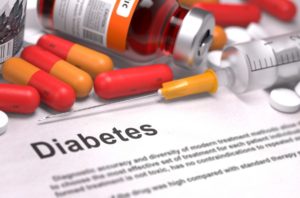What is Diabetes?
 Lifelong diseases often require ongoing treatment – but not all make it hard to enjoy a happy and active lifestyle. Currently, about 18.2 million Americans live with diabetes and over 40 million have pre-diabetes. There’s currently no cure available, but there are helpful treatment options that diabetic patients have accessible to manage their diabetic needs. An estimated 5.2 million Americans don’t even know they have diabetes so the Abraham Family & Geriatric Medicine providers want to share the characteristics of this disease and what you can do to stay healthy while living with diabetes.
Lifelong diseases often require ongoing treatment – but not all make it hard to enjoy a happy and active lifestyle. Currently, about 18.2 million Americans live with diabetes and over 40 million have pre-diabetes. There’s currently no cure available, but there are helpful treatment options that diabetic patients have accessible to manage their diabetic needs. An estimated 5.2 million Americans don’t even know they have diabetes so the Abraham Family & Geriatric Medicine providers want to share the characteristics of this disease and what you can do to stay healthy while living with diabetes.
What exactly is diabetes? Diabetes is the name given to a group of diseases that causes imbalances to the hormone insulin. Insulin is what our body’s produce from different kinds of foods we eat. The food is broken down to produce glucose – a simple sugar that the body uses to perform daily functions – and regulated by insulin released by the pancreas. Cells need glucose to function and the insulin acts as an aid to help absorb the glucose and turn it into useful energy. People with diabetes either don’t make enough insulin or have cells that are completely resistant to it (this insulin resistance leads to high blood sugar levels).
Diabetes is categorized into two major types:
Type 1 Diabetes – commonly found among young people under the age of 20 (though it can affect a person of any age), type 1 diabetes is when a person can’t produce insulin. Symptoms of type 1 diabetes include:
- Increased thirst or hunger (especially after eating)
- Dry mouth
- Frequent bathroom use
- Rapid, unexplained weight loss
- Fatigue or difficulty breathing
- Impaired vision
Type 1 diabetes sufferers may experience symptoms out of the blue and they can vary in severity, so if you’re experiencing chronic discomfort or pain, or have any of the above symptoms, it’s best to seek medical evaluation sooner than later.
Type 2 Diabetes – the most common of the two forms, there are about 18 million Americans living with type 2 diabetes today. People with this form of diabetes produce insulin naturally, but it may not always be enough and therefore must be regulated. Type 2 diabetes most typically affects people who are considered overweight and are over the age of 40 (though it can affect people who aren’t considered overweight as well), but unlike type 1 diabetes, type 2 diabetes can be prevented. Symptoms of type 2 diabetes include:
- Slow-healing cuts/sores
- Itchy skin (chronic skin irritation)
- Yeast infections
- Recent weight changes
Not all people with type 2 diabetes will experience noticeable symptoms and others may develop physical signs gradually.
Management of diabetes is the only option we have until researchers are able to discover an effective cure for diabetes. For both type 1 and type 2 diabetes we want to make sure that we keep blood sugar levels stable with a combination of medicine, a healthy lifestyle, and regular activity. People with type 1 diabetes will have to use insulin shots to control their blood sugar levels while people with type 2 diabetes need to control their weight, diet, and exercise routine to manage their disease – together we will find the best form of treatment to work for your unique needs.
The good news for people who are most likely to develop type 2 diabetes is that it can be prevented before it even starts. Our providers are able to identify pre-diabetics who have above-average blood sugar levels (pre-diabetics are people who aren’t quite at a high enough level to be considered diabetic but are headed in that direction), during an annual checkup and recommend appropriate treatment to help get the condition under control. We believe healthcare is a vital part of life and early prevention will only better serve you in the long run. If you’re interested in learning more about diabetes, diabetes management and treatment, or any of the family and geriatric services we offer, don’t hesitate to contact Abraham Family & Geriatric Medicine today.
